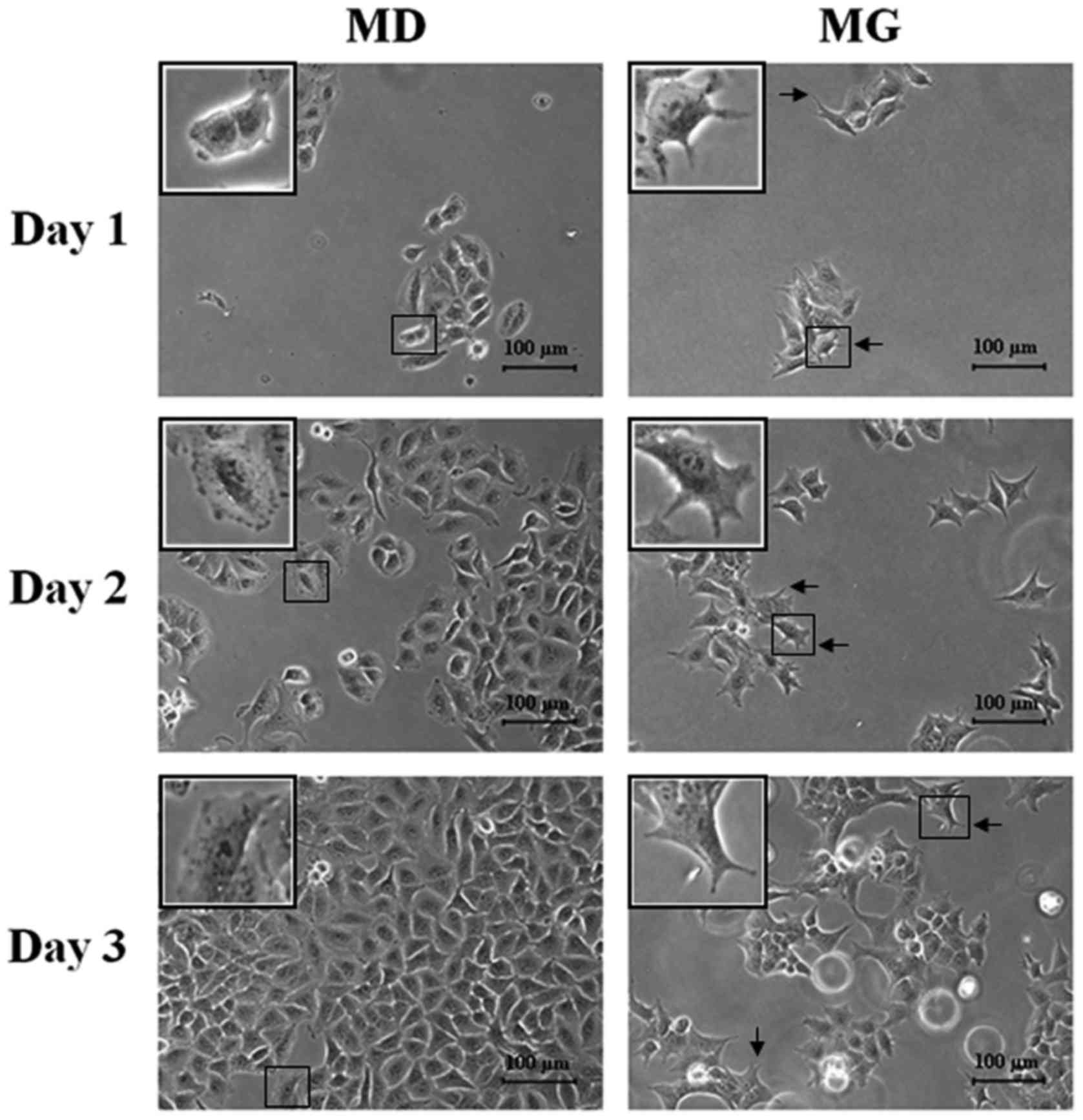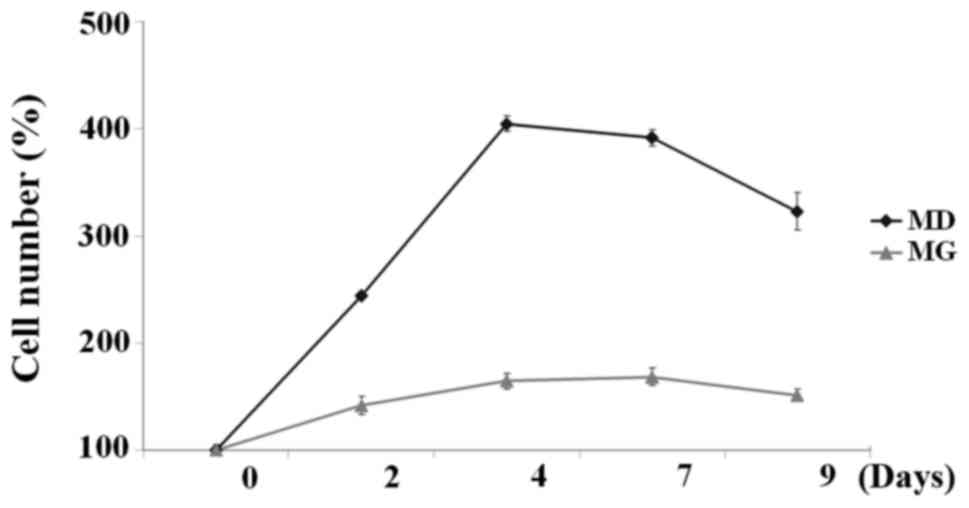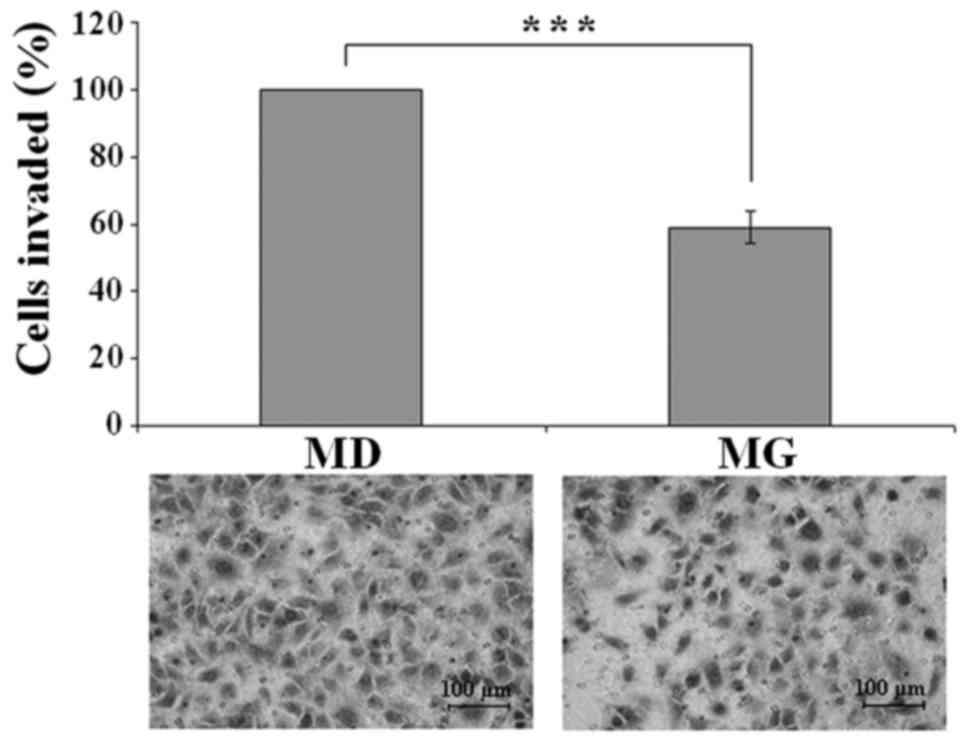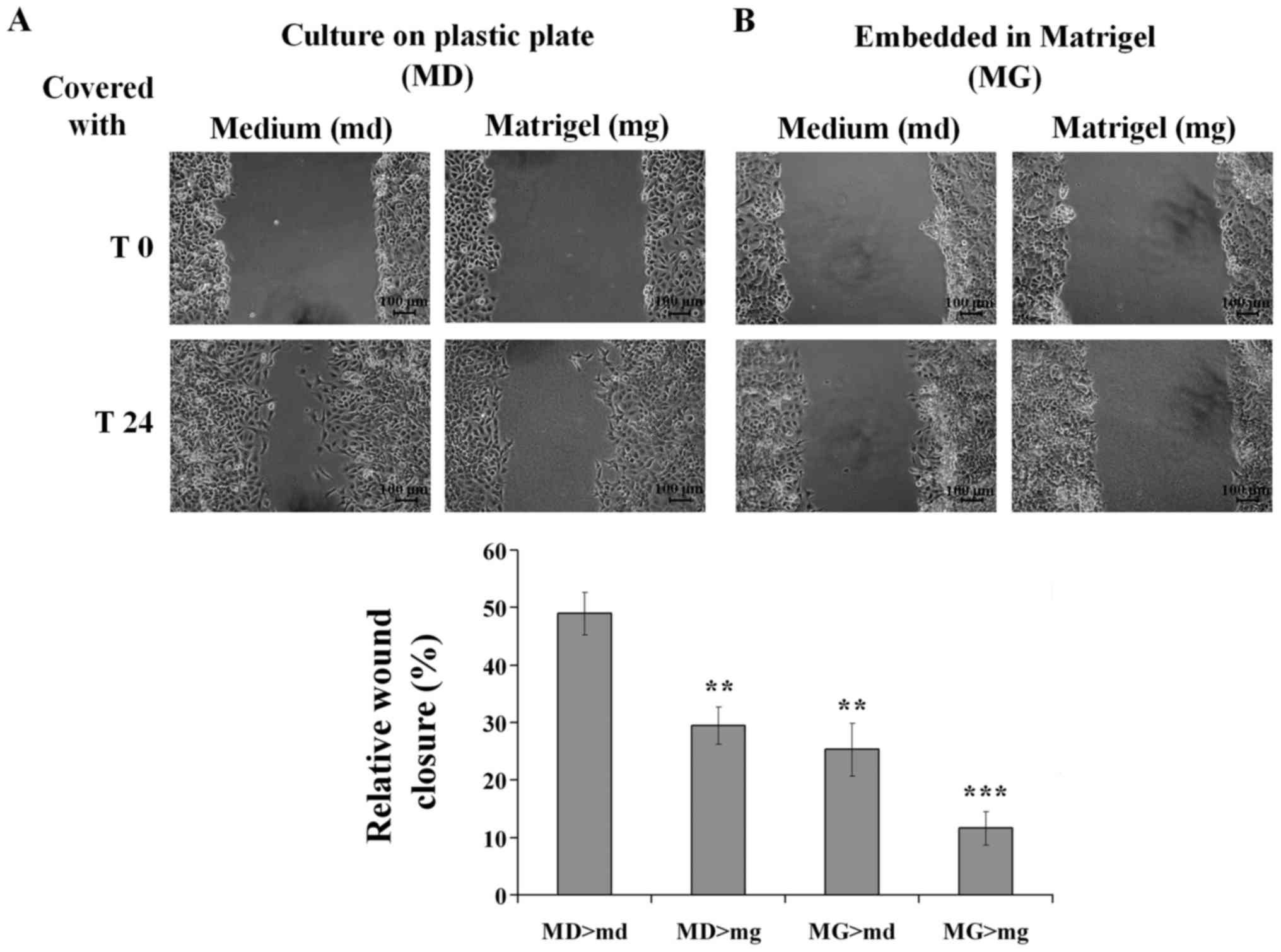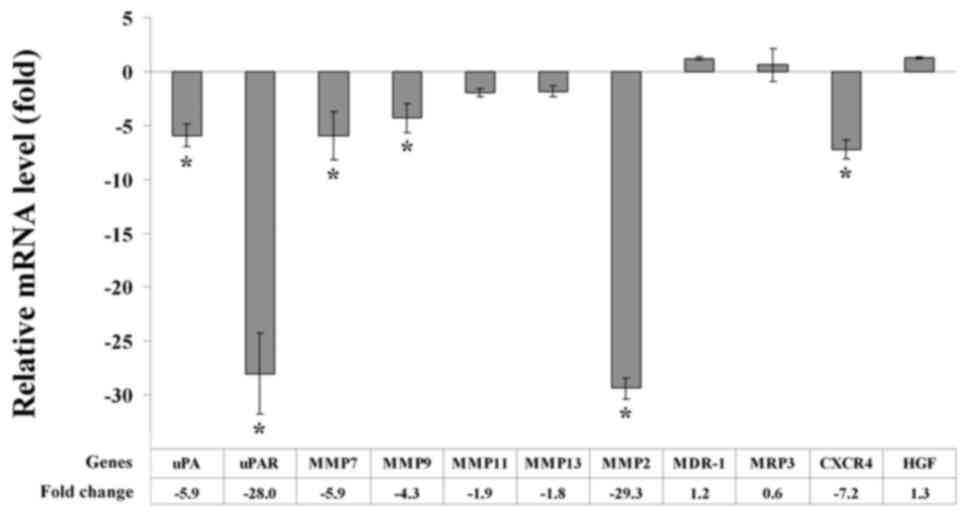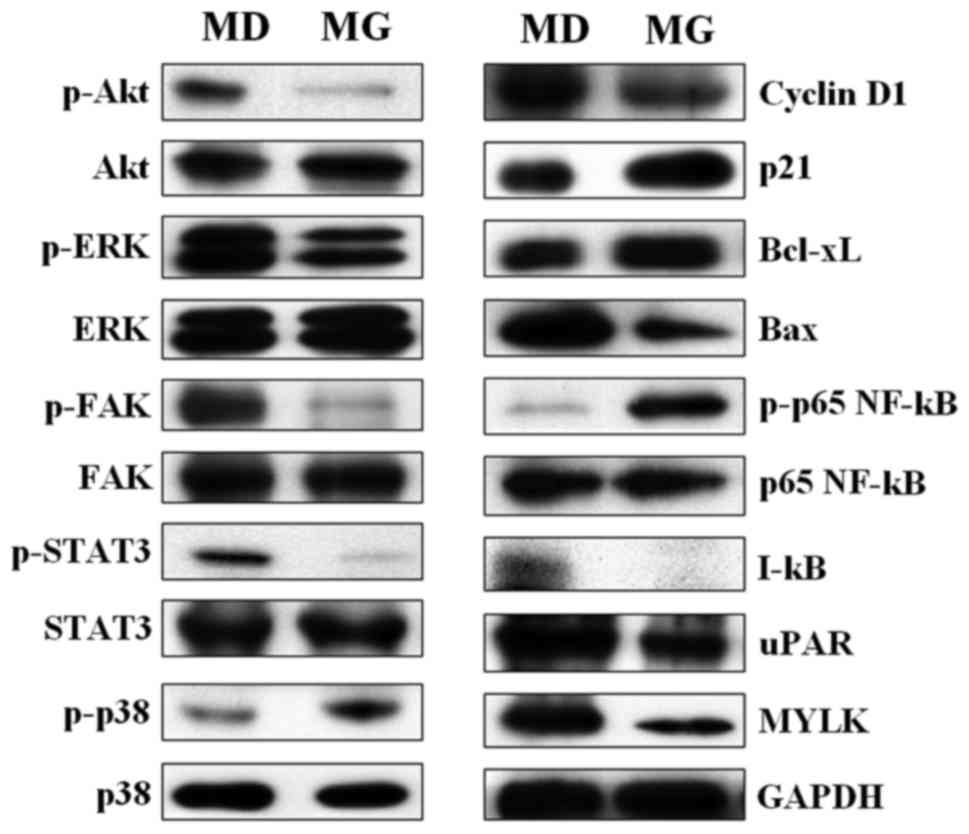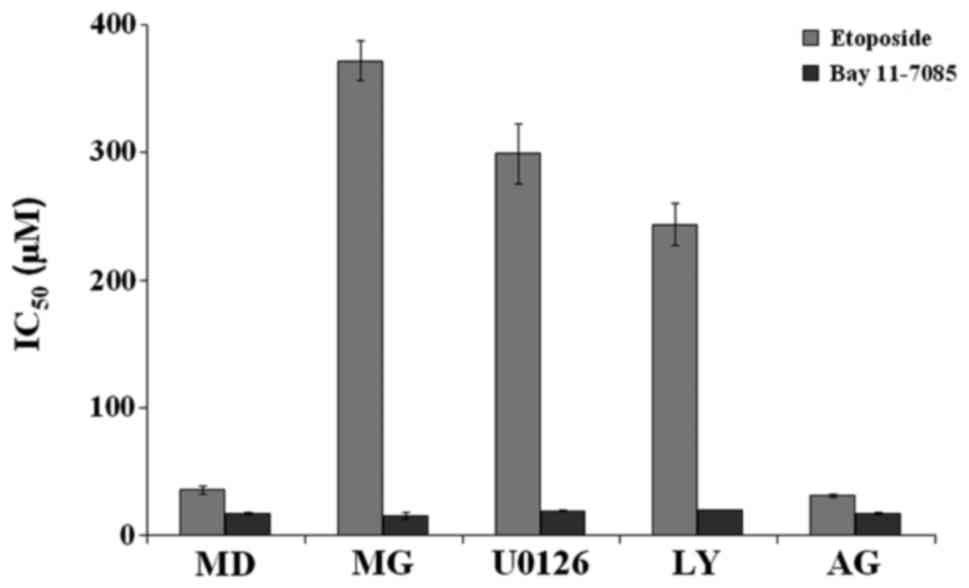|
1
|
Fridman R, Giaccone G, Kanemoto T, Martin
GR, Gazdar AF and Mulshine JL: Reconstituted basement membrane
(matrigel) and laminin can enhance the tumorigenicity and the drug
resistance of small cell lung cancer cell lines. Proc Natl Acad Sci
USA. 87:pp. 6698–6702. 1990; View Article : Google Scholar : PubMed/NCBI
|
|
2
|
Weaver VM, Fischer AH, Peterson OW and
Bissell MJ: The importance of the microenvironment in breast cancer
progression: Recapitulation of mammary tumorigenesis using a unique
human mammary epithelial cell model and a three-dimensional culture
assay. Biochem Cell Biol. 74:833–851. 1996. View Article : Google Scholar : PubMed/NCBI
|
|
3
|
Romero-López M, Trinh AL, Sobrino A, Hatch
MM, Keating MT, Fimbres C, Lewis DE, Gershon PD, Botvinick EL,
Digman M, et al: Recapitulating the human tumor microenvironment:
Colon tumor-derived extracellular matrix promotes angiogenesis and
tumor cell growth. Biomaterials. 116:118–129. 2017. View Article : Google Scholar : PubMed/NCBI
|
|
4
|
Cramer GM, Jones DP, El-Hamidi H and Celli
JP: ECM composition and rheology regulate growth, motility, and
response to photodynamic therapy in 3D models of pancreatic ductal
adenocarcinoma. Mol Cancer Res. 15:15–25. 2017. View Article : Google Scholar : PubMed/NCBI
|
|
5
|
Lin CQ and Bissell MJ: Multi-faceted
regulation of cell differentiation by extracellular matrix. FASEB
J. 7:737–743. 1993. View Article : Google Scholar : PubMed/NCBI
|
|
6
|
Streuli CH, Bailey N and Bissell MJ:
Control of mammary epithelial differentiation: Basement membrane
induces tissue-specific gene expression in the absence of cell-cell
interaction and morphological polarity. J Cell Biol. 115:1383–1395.
1991. View Article : Google Scholar : PubMed/NCBI
|
|
7
|
Muschler J, Lochter A, Roskelley CD,
Yurchenco P and Bissell MJ: Division of labor among the alpha6beta4
integrin, beta1 integrins, and an E3 laminin receptor to signal
morphogenesis and beta-casein expression in mammary epithelial
cells. Mol Biol Cell. 10:2817–2828. 1999. View Article : Google Scholar : PubMed/NCBI
|
|
8
|
Nakajima M, Morikawa K, Fabra A, Bucana CD
and Fidler IJ: Influence of organ environment on extracellular
matrix degradative activity and metastasis of human colon carcinoma
cells. J Natl Cancer Inst. 82:1890–1898. 1990. View Article : Google Scholar : PubMed/NCBI
|
|
9
|
Gohji K, Nakajima M, Boyd D, Dinney CP,
Bucana CD, Kitazana S, Kamidono S and Fidler IJ: Organ-site
dependence for the production of urokinase-type plasminogen
activator and metastasis by human renal cell carcinoma cells. Am J
Pathol. 151:1655–1661. 1997.PubMed/NCBI
|
|
10
|
Luzzi KJ, MacDonald IC, Schmidt EE,
Kerkvliet N, Morris VL, Chambers AF and Groom AC: Multistep nature
of metastatic inefficiency: Dormancy of solitary cells after
successful extravasation and limited survival of early
micrometastases. Am J Pathol. 153:865–873. 1998. View Article : Google Scholar : PubMed/NCBI
|
|
11
|
Naumov GN, MacDonald IC, Weinmeister PM,
Kerkvliet N, Nadkarni KV, Wilson SM, Morris VL, Groom AC and
Chambers AF: Persistence of solitary mammary carcinoma cells in a
secondary site: A possible contributor to dormancy. Cancer Res.
62:2162–2168. 2002.PubMed/NCBI
|
|
12
|
Naumov GN, Townson JL, MacDonald IC,
Wilson SM, Bramwell VH, Groom AC and Chambers AF: Ineffectiveness
of doxorubicin treatment on solitary dormant mammary carcinoma
cells or late-developing metastases. Breast Cancer Res Treat.
82:199–206. 2003. View Article : Google Scholar : PubMed/NCBI
|
|
13
|
Barkan D, Kleinman H, Simmons JL, Asmussen
H, Kamaraju AK, Hoenorhoff MJ, Liu ZY, Costes SV, Cho EH, Lockett
S, et al: Inhibition of metastatic outgrowth from single dormant
tumor cells by targeting the cytoskeleton. Cancer Res.
68:6241–6250. 2008. View Article : Google Scholar : PubMed/NCBI
|
|
14
|
Boyerinas B, Zafrir M, Yesilkanal AE,
Price TT, Hyjek EM and Sipkins DA: Adhesion to osteopontin in the
bone marrow niche regulates lymphoblastic leukemia cell dormancy.
Blood. 121:4821–4831. 2013. View Article : Google Scholar : PubMed/NCBI
|
|
15
|
Ghajar CM, Peinado H, Mori H, Matei IR,
Evason KJ, Brazier H, Almeida D, Koller A, Hajjar KA, Stainier DY,
et al: The perivascular niche regulates breast tumour dormancy. Nat
Cell Biol. 15:807–817. 2013. View
Article : Google Scholar : PubMed/NCBI
|
|
16
|
Oridate N, Lotan R and Lotan D:
Reconstituted basement membrane (Matrigel): A useful semisolid
medium for growth of tumor cell colonies. In Vitro Cell Dev Biol
Anim. 32:192–193. 1996. View Article : Google Scholar : PubMed/NCBI
|
|
17
|
Kleinman HK and Martin GR: Matrigel:
Basement membrane matrix with biological activity. Semin Cancer
Biol. 15:378–386. 2005. View Article : Google Scholar : PubMed/NCBI
|
|
18
|
Alley MC, Scudiero DA, Monks A, Hursey ML,
Czerwinski MJ, Fine DL, Abbott BJ, Mayo JG, Shoemaker RH and Boyd
MR: Feasibility of drug screening with panels of human tumor cell
lines using a microculture tetrazolium assay. Cancer Res.
48:589–601. 1988.PubMed/NCBI
|
|
19
|
Livak KJ and Schmittgen TD: Analysis of
relative gene expression data using real-time quantitative PCR and
the 2ΔΔCT method. Methods. 25:402–408. 2001. View Article : Google Scholar : PubMed/NCBI
|
|
20
|
Meltzer A: Dormancy and breast cancer. J
Surg Oncol. 43:181–188. 1990. View Article : Google Scholar : PubMed/NCBI
|
|
21
|
Karrison TG, Ferguson DJ and Meier P:
Dormancy of mammary carcinoma after mastectomy. J Natl Cancer Inst.
91:80–85. 1999. View Article : Google Scholar : PubMed/NCBI
|
|
22
|
Aguirre-Ghiso JA: Models, mechanisms and
clinical evidence for cancer dormancy. Nat Rev Cancer. 7:834–846.
2007. View
Article : Google Scholar : PubMed/NCBI
|
|
23
|
Yu W, Kim J and Ossowski L: Reduction in
surface urokinase receptor forces malignant cells into a protracted
state of dormancy. J Cell Biol. 137:767–777. 1997. View Article : Google Scholar : PubMed/NCBI
|
|
24
|
Radinsky R: Modulation of tumor cell gene
expression and phenotype by the organ-specific metastatic
environment. Cancer Metastasis Rev. 14:323–338. 1995. View Article : Google Scholar : PubMed/NCBI
|
|
25
|
Fidler IJ: Seed and soil revisited:
Contribution of the organ microenvironment to cancer metastasis.
Surg Oncol Clin N Am. 10:257–269. 2001.PubMed/NCBI
|
|
26
|
Henriet P, Zhong ZD, Brooks PC, Weinberg
KI and DeClerck YA: Contact with fibrillar collagen inhibits
melanoma cell proliferation by up-regulating p27KIP1. Proc Natl
Acad Sci USA. 97:pp. 10026–10031. 2000; View Article : Google Scholar : PubMed/NCBI
|
|
27
|
Roth JM, Akalu A, Zelmanovich A,
Policarpio D, Ng B, MacDonald S, Formenti S, Liebes L and Brooks
PC: Recombinant alpha2(IV)NC1 domain inhibits tumor
cell-extracellular matrix interactions, induces cellular
senescence, and inhibits tumor growth in vivo. Am J Pathol.
166:901–911. 2005. View Article : Google Scholar : PubMed/NCBI
|
|
28
|
Li X, Tsai P, Wieder ED, Kribben A, Van
Putten V, Schrier RW and Nemenoff RA: Vascular smooth muscle cells
grown on Matrigel. A model of the contractile phenotype with
decreased activation of mitogen-activated protein kinase. J Biol
Chem. 269:19653–19658. 1994.PubMed/NCBI
|
|
29
|
Souter LH, Andrews JD, Zhang G, Cook AC,
Postenka CO, Al-Katib W, Leong HS, Rodenhiser DI, Chambers AF and
Tuck AB: Human 21T breast epithelial cell lines mimic breast cancer
progression in vivo and in vitro and show stage-specific gene
expression patterns. Lab Invest. 90:1247–1258. 2010. View Article : Google Scholar : PubMed/NCBI
|
|
30
|
Aguirre Ghiso JA, Kovalski K and Ossowski
L: Tumor dormancy induced by downregulation of urokinase receptor
in human carcinoma involves integrin and MAPK signaling. J Cell
Biol. 147:89–104. 1999. View Article : Google Scholar : PubMed/NCBI
|
|
31
|
Aguirre Ghiso JA, Liu D, Mignatti A,
Kovalski K and Ossowski L: Urokinase receptor and fibronectin
regulate the ERKMAPK to p38MAPK activity
ratios that determine carcinoma cell proliferation or dormancy in
vivo. Mol Biol Cell. 12:863–879. 2001. View Article : Google Scholar : PubMed/NCBI
|
|
32
|
Pavón MA, Arroyo-Solera I, Céspedes MV,
Casanova I, León X and Mangues R: uPA/uPAR and SERPINE1 in head and
neck cancer: Role in tumor resistance, metastasis, prognosis and
therapy. Oncotarget. 7:57351–57366. 2016. View Article : Google Scholar : PubMed/NCBI
|
|
33
|
Aguirre Ghiso JA: Inhibition of FAK
signaling activated by urokinase receptor induces dormancy in human
carcinoma cells in vivo. Oncogene. 21:2513–2524. 2002. View Article : Google Scholar : PubMed/NCBI
|
|
34
|
Modi PK, Komaravelli N, Singh N and Sharma
P: Interplay between MEK-ERK signaling, cyclin D1, and
cyclin-dependent kinase 5 regulates cell cycle reentry and
apoptosis of neurons. Mol Biol Cell. 23:3722–3730. 2012. View Article : Google Scholar : PubMed/NCBI
|
|
35
|
Rössig L, Jadidi AS, Urbich C, Badorff C,
Zeiher AM and Dimmeler S: Akt-dependent phosphorylation of
p21Cip1 regulates PCNA binding and proliferation of
endothelial cells. Mol Cell Biol. 21:5644–5657. 2001. View Article : Google Scholar : PubMed/NCBI
|
|
36
|
Hodkinson PS, Mackinnon AC and Sethi T:
Extracellular matrix regulation of drug resistance in small-cell
lung cancer. Int J Radiat Biol. 83:733–741. 2007. View Article : Google Scholar : PubMed/NCBI
|
|
37
|
Said G, Guilbert M, Morjani H, Garnotel R,
Jeannesson P and El Btaouri H: Extracellular matrix proteins
modulate antimigratory and apoptotic effects of Doxorubicin.
Chemother Res Pract. 2012:2686812012.PubMed/NCBI
|
|
38
|
Majidinia M and Yousefi B: Breast tumor
stroma: A driving force in the development of resistance to
therapies. Chem Biol Drug Des. 89:309–318. 2017. View Article : Google Scholar : PubMed/NCBI
|
|
39
|
Fidler IJ, Wilmanns C, Staroselsky A,
Radinsky R, Dong Z and Fan D: Modulation of tumor cell response to
chemotherapy by the organ environment. Cancer Metastasis Rev.
13:209–222. 1994. View Article : Google Scholar : PubMed/NCBI
|
|
40
|
Dalton WS: The tumor microenvironment as a
determinant of drug response and resistance. Drug Resist Updat.
2:285–288. 1999. View Article : Google Scholar : PubMed/NCBI
|
|
41
|
Buttery RC, Rintoul RC and Sethi T: Small
cell lung cancer: The importance of the extracellular matrix. Int J
Biochem Cell Biol. 36:1154–1160. 2004. View Article : Google Scholar : PubMed/NCBI
|
|
42
|
Godwin P, Baird AM, Heavey S, Barr MP,
O'Byrne KJ and Gately K: Targeting nuclear factor-kappa B to
overcome resistance to chemotherapy. Front Oncol. 3:1202013.
View Article : Google Scholar : PubMed/NCBI
|
|
43
|
Ughachukwu P and Unekwe P: Efflux
pump-mediated resistance in chemotherapy. Ann Med Health Sci Res.
2:191–198. 2012. View Article : Google Scholar : PubMed/NCBI
|
|
44
|
Liu H, Patel MR, Prescher JA, Patsialou A,
Qian D, Lin J, Wen S, Chang YF, Bachmann MH, Shimono Y, et al:
Cancer stem cells from human breast tumors are involved in
spontaneous metastases in orthotopic mouse models. Proc Natl Acad
Sci USA. 107:pp. 18115–18120. 2010; View Article : Google Scholar : PubMed/NCBI
|
|
45
|
Pajonk F, Vlashi E and McBride WH:
Radiation resistance of cancer stem cells: The 4 R's of
radiobiology revisited. Stem Cells. 28:639–648. 2010. View Article : Google Scholar : PubMed/NCBI
|
|
46
|
D'Andrea FP: Intrinsic radiation
resistance of mesenchymal cancer stem cells and implications for
treatment response in a murine sarcoma model. Dan Med J.
59:B43882012.PubMed/NCBI
|
|
47
|
LaBarge MA: The difficulty of targeting
cancer stem cell niches. Clin Cancer Res. 16:3121–3129. 2010.
View Article : Google Scholar : PubMed/NCBI
|
|
48
|
Lacerda L, Pusztai L and Woodward WA: The
role of tumor initiating cells in drug resistance of breast cancer:
Implications for future therapeutic approaches. Drug Resist Updat.
13:99–108. 2010. View Article : Google Scholar : PubMed/NCBI
|
|
49
|
Wang Z, Li Y, Ahmad A, Azmi AS, Kong D,
Banerjee S and Sarkar FH: Targeting miRNAs involved in cancer stem
cell and EMT regulation: An emerging concept in overcoming drug
resistance. Drug Resist Updat. 13:109–118. 2010. View Article : Google Scholar : PubMed/NCBI
|
|
50
|
Trumpp A, Essers M and Wilson A: Awakening
dormant haematopoietic stem cells. Nat Rev Immunol. 10:201–209.
2010. View Article : Google Scholar : PubMed/NCBI
|
|
51
|
Endo H, Okuyama H, Ohue M and Inoue M:
Dormancy of cancer cells with suppression of AKT activity
contributes to survival in chronic hypoxia. PLoS One. 9:e988582014.
View Article : Google Scholar : PubMed/NCBI
|
|
52
|
Li Q, Chow AB and Mattingly RR:
Three-dimensional overlay culture models of human breast cancer
reveal a critical sensitivity to mitogen-activated protein kinase
kinase inhibitors. J Pharmacol Exp Ther. 332:821–828. 2010.
View Article : Google Scholar : PubMed/NCBI
|















